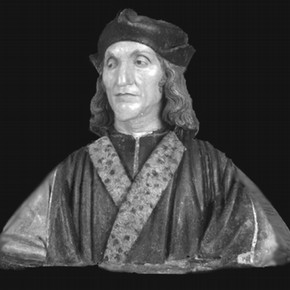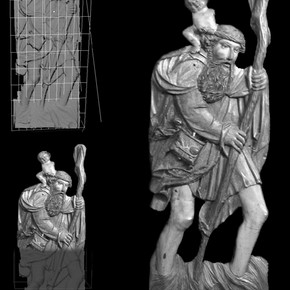Conservation Journal
July 1999 Issue 32
Three Dimensional Digital Visualisation: Research in Progress

Figure 1. A model captured using VIVID™ from Torregiano's terracotta bust of Henry VII (Museum No. A.49-1935) textured and rendered in 3D Studio Max™ on PC running NT4™ (click image for larger version)
When I began my research in 1997 my aim was to explore possible approaches for the accurate capture of three-dimensional (3D) data from museum objects using existing technology and to define a reproducible and accessible methodology for this procedure. My final goal was to use the resulting 3D models in computer simulations of the likely original appearance of artefacts. While a degree of subjectivity is implicit, scholarly interpretation is paramount in this endeavour and I anticipated drawing extensively on historical and analytical information.
There are several high-profile current 3D-capture studies ongoing around the world, including those of the National Research Council of Canada (NRC) in conjunction with the Canadian Conservation Institute (CCI) 1 and, more recently, Stanford University's Virtual Michelangelo Project 2 . These have relied on very high specification, costly scanning devices and computer technology. From the outset, it has been my intention to use technology which is realistically accessible in terms of cost and availability. To that end I hope that the groundwork laid by my project will be useful to other institutions or individuals wishing to implement 3D capture for their collections.
I chose Northern, late Gothic, polychrome sculptures as the focus for my research. My interest in painted surfaces, allied with the extreme deterioration often suffered by these works, were significant reasons for my choice, but the extensive and well-researched collection available within the V&A was also an important factor. For the most part, sacred wooden carvings from the selected period are being scanned, but I have also collected digitised information from some stone and terracotta pieces (Figure 1).
Digitally capturing the geometry of sculptures presents many technical challenges given the limitations of current technology. The dynamic and vigorous style of carving favoured from the early Renaissance amongst the limewood sculptors of Germany and Northern Europe can be particularly problematic. Deep undercut relief is often employed and drapery surges and swirls in complex undulations. The scanning devices used in the project, and indeed most currently available, cannot readily capture data from deeply recessed forms and the specific choice of objects was constrained to some extent by this factor. Dark colours and highly reflective surfaces can also reduce the effectiveness of laser-capture images.
The project has utilised a laser scanning system called VIVID™ (VI 700), and a live photogrammetric capture device: Tricorder™S4M. Both systems were lent to the Museum by Tricorder Technology plc. The former produces digital models which appear as polygonal meshes. These are of moderate resolution 3 , adequate for the purposes of multimedia display. During capture, a series of scans taken as the object is progressively rotated (or translated) are needed to build the entire model. Then the multiple surfaces are registered either manually or automatically using the scanner software. I found that manual selection of reference points by visual comparison of picture images more consistently resulted in accurate alignment.
It has become evident during the course of the project that the quality of this software plays a significant role in the success of the final model. With VIVID™ the capture of range data on dimension and form is limited to the parts of the objects visible to the laser scan. Undercut regions, overhanging features and so on are not completely recorded, resulting in black holes in the final model. At a later stage, the operating software can be used to correct any defects by point editing, after which the final polygonal mesh models are exported in one of the several industry standard formats for further editing, rendering and animation in modelling applications.

Figure 2. This image shows three stages of assigning a 2D colour bitmap of a model of a Flemish polychrome scultpture of St Christopher (Museum No. A1304-1872) (click image for larger version)
A secondary, but essential, element in creating a realistic model is the two-dimensional (2D) image or texture map wrapped around the 3D form (Figure 2). The quality of the 2D digital images provided by VIVID™ are disappointing; too low in resolution and often poorly focused due to the lack of manual control over the camera optics. For this reason, and to allow fine control over the final appearance of the models, high resolution digital images are captured from large format colour transparencies or 35mm slides of the objects. These are then manipulated as required using applications such as Photoshop™. In this respect my study has benefited from Nicholas Frayling's research into 2D computer 4 imaging .
In respect of visualisation, surface characteristics are of particular interest to me. My research engages with all aspects of the paint, gilding and other decorative layers. Determination of original appearance relies to a considerable extent on scientific analysis, documentary and historical evidence. Valuable colour referencing data can also be extracted from cleaning tests and samples.
Given the functional nature of these symbolic sculptures, it was not unusual for their surfaces to be subject to many changes in the course of time. Successive layers of repainting may have been applied, and during the Reformation partial or complete destruction may have been the final fate of the original polychromy. Normal ageing, as well as the attentions of earlier restorers, also contribute to surface change. Digital imaging is extremely well suited as a tool for exploring and reconstructing changing appearance, drawing together all the available visual and technical information.
Once a model is captured, refined and exported, it can be adapted to a wide range of visualisation applications, both educational and professional. In conservation there are many advantages in using high resolution 3D models as a form of documentation. It can be far more informative and flexible than conventional photography or 2D imaging. The models can be rotated and viewed from any angle, dimensional change can be recorded and analysed to a high degree of accuracy and volumetric data can be extracted. The process of conservation treatment can be aided by allowing the possible outcome of proposed conservation strategies to be viewed virtually and evaluated prior to implementation.
Treatments which are not normally feasible in reality because of their invasive nature can also be explored. Virtual representations of objects may present an alternative, in some cases, to restoration. To this end multimedia consoles can be displayed alongside conserved, but unrestored objects, serving to illustrate the visual outcome of restoration and enhance the viewer's understanding of the piece. Objects can also be placed in interactive virtual environments which reproduce their original setting, such as churches or cathedrals. This simulation can incorporate factors such as changing ambient light: sunlight at different times of day or year and candlelight.
There are also obvious implications in 3D image-processing for the accessibility of collections. Databases of artefacts, on display or in storage, can be explored on consoles by gallery visitors and scholars, or anywhere in the world via the internet and CD-ROM distribution. It is also possible to produce accurate facsimiles of objects to scale from captured data. One use for this could be enhanced access by touch for visually impaired visitors.
At the conclusion of my research I plan to use immersive technologies such as head-mounted displays and walk-in environments for the display of virtual presentations produced as the outcome of the project.
In October 1998 a third computer-imaging research student, Athanasios Velios, joined Nicholas Frayling and myself on the Course to study the 3D capture and digitally-assisted surface alignment of fragmented objects. This is an exciting time to be exploring this rapidly-evolving area, as our small group gradually expands in size and diversity.
Acknowledgements
I am grateful to Professor Alan Cummings and Richard Cook for their continued support of my project, both practical and moral. Many thanks also to: Michael Le Fleming, Duncan Hughes and Graham Arnold of Tricorder Technology plc.
References
1. Baribeau, R, Godin, G. Cournoyer, L. and Rioux, M. Colour Three-Dimensional Modelling of Museum Objects: Imaging the Past: Electronic Imaging and Computer Graphics in Museums and Archaeology, Occasional Paper Number 114, British Museum, London, 1996.
2.http://graphics.stanford.edu/papers/digmich_falletti/
3. Approximate resolutions between 0.3mm and 10mm depending on scanning distance and zoom level
4. Frayling, Nick., An exploration of the original appearanceof Nicholas Hilliard's portrait miniatures using computer image manipluation, V&A Conservation Journal 28, July 1998, pp.4-6.
Angela Geary
2a 162 Abbey Street London SE1 2AN
phone/fax 0171 237 8694
email: infinity@writeme.com

July 1999 Issue 32
- Editorial - A Taste for the New?
- The RCA/V&A Conservation Course: Changes Over Time
- Old Treatment, New Problem: Bakelite as a Consolidant
- An Improved Storage System for the Clock Collection
- Three Dimensional Digital Visualisation: Research in Progress
- Not So New Methods of Cleaning
- So that's why Textile Conservation has such a Big Studio! - Tapesty Washing at the V&A
- Energy Efficient Pollution Control in Museums and Galleries
- Science Surgery
- Printer Friendly Version